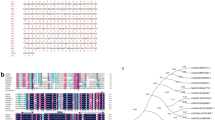Abstract
Enzyme activities and transcripts of alcohol dehydrogenase (ADH) were analyzed in a single recessive rice (Oryza sativa L.) mutant with reduced ADH activity (rad). It has been previously demonstrated that all ADH isozymes are below the level of detection in aerobically grown rad seedlings (Matsumura et al. 1995). The present study showed that ADH activity was anaerobically inducible in rad seedlings and predominantly localized in the roots, mainly in the root-cap region. The lowest band (ADH2 homodimer) of the ADH isozymes was observed in submerged rad seedlings. Although two isozymes (the ADH1 homodimer and heterodimer), abundant in the wild-type, were lost in this mutant, Adh1 mRNA was produced normally in aerated or submerged rad plants. Protein analysis showed that the amount of ADH protein was reduced in rad seedlings. Most likely, Adh1 mRNA was not translated or else its product was unstable in rad plants. The viability of submerged rad seedlings was evaluated by the growth and greening of the shoots. Our results showed that rad seedlings were more vulnerable to a long-term submergence stress than wild-type seedlings.
Similar content being viewed by others
Author information
Authors and Affiliations
Additional information
Received: 6 August 1997 / Accepted: 26 May 1998
Rights and permissions
About this article
Cite this article
Matsumura, H., Takano, T., Takeda, G. et al. Adh1 is transcriptionally active but its translational product is reduced in a rad mutant of rice (Oryza sativa L.), which is vulnerable to submergence stress. Theor Appl Genet 97, 1197–1203 (1998). https://doi.org/10.1007/s001220051010
Issue Date:
DOI: https://doi.org/10.1007/s001220051010




